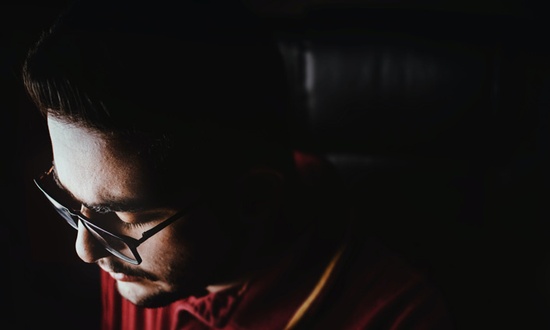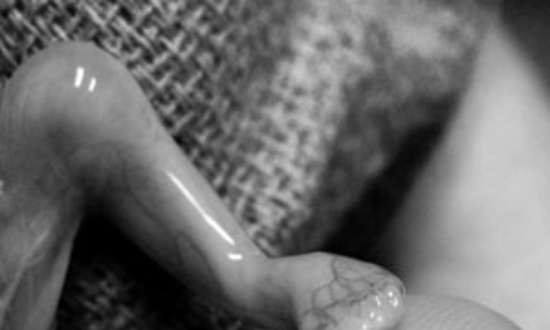Note from Randy: I was touched by this article by Marshall Shelley years ago, and touched again as I reread it. We asked Marshall if we could share it, 30 years after it was first published on May 16, 1994, and he graciously said yes. (Marshall previously served as an editor and vice president at Christianity Today International for thirty-four years, including several years as executive editor of Christian History magazine.)
For many of us, the list of people we’re longing for reunion with in Heaven is lengthy. But those who have lost children, like Marshall and his wife Susan, have even more compelling reasons to long for Heaven. His writing beautifully demonstrates an eternal perspective on every human life. Whether or not you’ve lost a child in a miscarriage or after birth, I think you’ll be moved by what he shares. Thank you, Marshall and Susan.
Two Minutes to Eternity
Why would God allow the “miracle of birth” to be followed so closely by the mystery of death?
By Marshall Shelley
I was with my son his entire life. Two minutes.
He entered the world of light and air at 8:20 p.m. on November 22, 1991. And he departed, the doctor said, at 8:22.
It seemed a very short time. Too short. My wife, Susan, and I never got to see him take his first steps. We barely got to see him take his first breath.
I don’t know if he would have enjoyed softball or software, dinosaurs or dragonflies, machines or math. We never got to wrestle, race, or read—would he have enjoyed those things like his older sisters do? What would have made him laugh? Made him scared? Made him angry?
Those questions swarmed around my soul in the days following my son’s arrival and all-too-hurried departure. So many things I wondered. But one question loomed larger than all the rest, haunting me for months: Why would God create a child to live two minutes?
Many tragic deaths can be blamed on human cruelty or foolishness. A stray bullet punctures a tenement wall and kills an infant. A driver loses control of a car and careens into a group of schoolchildren on the sidewalk. Senseless. Heartbreaking. But at least I know where to direct my anger.
With my son, no direct human responsibility could be charged in his death. It was a “chromosomal abnormality” called Trisomy 13. One of the 23 sets of chromosomes developed a third appendage. Despite genetic tests and the expert opinions of doctors, we discovered no known cause for this condition.
As far as I was concerned, this was a design flaw. And the Designer was directly responsible.
I remember the first time I heard the term “Trisomy 13.” It was the same hour I first saw my son—as ghostly black-white-and-gray movements on the sonogram screen. In silence, Susan and I watched the embryonic motions as Dr. Silver manipulated the ultrasound, measuring the cranium and the femur and viewing the internal organs.
“Is everything okay?” I asked.
“Let me complete the examination, and I’ll give you a full report,” he said. I noted his evasive answer and hoped this was merely his standard procedure.
Moments later, he announced his observations in a matter-of-fact voice: “We have some problems. The fetus has a malformed heart—the aorta is attached incorrectly. There are missing portions of the cerebellum. A club foot. A cleft palate and perhaps a cleft lip. Possibly spina bifida. This is probably a case of Trisomy 13 or Trisomy 18. In either case, it is a condition incompatible with life.”
Neither Susan nor I could say anything. So Dr. Silver continued.
“It's likely the fetus will spontaneously miscarry. If the child is born, it will not survive long outside the womb. You need to decide if you want to try to carry this pregnancy to term.”
We both knew what he was asking. I was speechless. Susan found her voice first. Though shaken by the news, she said softly but clearly, “We believe God is the giver and taker of life. If the only opportunity I have to know this child is in my womb, I don’t want to cut that time short. If the only world he is to know is the womb, I want that world to be as safe as I can make it.”
We left the medical center that July afternoon stunned and saddened.
“Pregnancy is hard enough when you know you're going to leave the hospital with a baby,” Susan said. “I don't know how I can go through the pain of childbirth knowing I won’t have a child to hold.”
Signs of the Pneuma
Summer turned to fall, and we were praying that our son would be healed. And if a long life were not God's intention for him, we prayed that he could at least experience the breath of life. We longed to see that reminder of God's Spirit, the Pneuma, flow through him like a gentle wind.
Even that request seemed in jeopardy as labor began November 22. As the contractions got more severe, signs of fetal distress caused the nurses to ask, “Should we try to deliver the baby alive?”
“Yes, if at all possible, short of surgery,” Susan replied.
They kept repositioning Susan and gave her oxygen, and the fetal distress eased.
And then suddenly the baby was out. The doctor cut the cord and gently placed him on Susan's chest. He was a healthy pink, and we saw his chest rise and fall. The breath of life. Thank you, God.
Then, almost immediately, he began to turn blue. We stroked his face and whispered words of welcome, of love, of farewell. And all too soon the doctor said, “He's gone.”
Within minutes, our pastor, our parents, and our children came into the room. Together we wept, held one another, and took turns holding our son. My chest ached from heaviness. Death is enormous, immense, unstoppable.
The loss was crushing, but mingled with the tears and the terrible pain was something else. I’m not sure I can describe it.
At the births of my three older daughters, I’d felt “the miracle of birth,” that sacred moment when a new life enters the world of light and air. The pneuma, the breath of life, fills the lungs for the first time. Now this moment was doubly intense because the miracle of birth was followed so quickly by the mystery of death. The pneuma was here and now gone.
“It feels like eternity just intersected earth” was all I could say to our pastor. The pain of grief was diminished not at all, but it blended with the weight of overwhelming wonder at the irresistible movement from time to eternity.
“Do you have a name for the baby?” asked one of the nurses.
“Toby,” Susan said. “It’s short for a biblical name, Tobiah, which means ‘God is good.’”
We had long thought about the name for this child. We didn’t particularly feel God’s goodness at that moment. The name was what we believed, not what we felt. It was what we wanted to feel again someday.
The words of C.S. Lewis, describing the lion Aslan, kept coming to mind: “He's not a tame lion. But he's good.” We clung to that image of untamed and fearsome goodness, even as we continued to struggle with the question: Why would God create a child to live two minutes?
Everything Has an Inside
Shortly before we discovered Toby’s condition, I read a book by Christopher de Vinck, The Power of the Powerless, in which he describes what he learned from his severely and profoundly retarded brother, Oliver.
I was interested because our third daughter, Mandy, was also severely retarded, unable to respond to her environment. And just three months after Toby’s birth and death, Mandy also entered eternity. She was two weeks shy of her second birthday. One of the points de Vinck made about Oliver helped me with the God-directed questions I had after Toby’s birth and death.
One of the greatest discoveries that a child or an adult can make, writes de Vinck, is that “everything has an inside. In our house, we split apples to look at the core, we crack walnuts to see the meat inside, we press a toy stethoscope to our chests to listen to the heartbeat.”
The point: you can't always guess what’s on the inside by looking at the outside.
The Bible says that “Man looks on the outward appearance, but God looks on the heart.” That was true then. It’s true now. We’re so outer focused. We’re taught to judge people by the stylishness of their clothing labels. Political campaigns are crafted by scriptwriters, TV directors, and pollsters. Educational policies are based on appearances of political correctness. We’re tempted to believe that image is everything, that outward appearances are most important. We ignore the inside, the heart, the spirit.
Each of my children also has an inside. With my two older girls, I get occasional glimpses of their interior life. Their words and actions give me clues about their inner worlds. With Mandy, the glass was darker. And with Toby, we never had a chance to see inside.
But Mandy and Toby both had insides. Despite the damage to the outer frame, the inside is to be treasured.
Our Unearthly Calling
Not long after we buried Toby and Mandy, our seven-year-old daughter, Stacey, told us she heard God's voice in the middle of the night telling her that “Mandy and Toby are very busy. They are building our house, and they are guarding his throne.”
Not knowing how to respond to a child who had never offered a claim like that before, I found myself reading the Bible with renewed interest in descriptions of heavenly activities. Was this message consistent with Scripture? Our family discussions usually focused on Heaven.
We saw that Heaven is a place of activity, not just leisure or ease. God is preparing a city for the faithful (Heb. 11:16), where all will be made perfect and complete (Heb. 11:40). The Bible contains many descriptions of heavenly worship as active and intense.
And since Jesus said that in his Father's house are “many mansions” and he was going to prepare a place for us (John 14), we could easily envision part of our heavenly activity being to help prepare for those yet to arrive.
I must admit, however, that I was more intrigued by the image of guarding Christ's throne. Was this an honor guard? A ceremonial assemblage of children, whom Christ on earth had invited to be near him? Or perhaps seats of honor for those Christ had in mind when he said, “The last shall be first”? I can’t think of many more “last” than Mandy and Toby.
But what if guarding the throne isn’t ceremonial but actual? Daniel 10 describes the angel Michael in conflict with a spiritual foe. Ephesians 6:12 describes a struggle “against the spiritual forces of evil in the heavenly realms.” Could it be that among the spiritual warriors in this conflict is one named Toby?
The Book of Revelation records battles involving heavenly armies (Rev. 19:19). Could it be that along with countless others of us, Toby will serve among the heavenly hosts in that final great war?
All of this, of course, is conjecture. But what is clear is that Heaven will be a place of active duty.
And when the ultimate spiritual battle is over, our responsibilities continue.
The apostle John’s vision of eternity suggests what’s in store for all the saints: “The throne of God and of the Lamb will be in the city, and his servants will serve him. They will see his face, and his name will be on their foreheads …. And they will reign forever and ever” (Rev. 22:3-5).
I don’t know exactly what our service in that city will involve, nor can I be specific about how we will assist in reigning. But those tasks sound like they may have a bit more significance than most careers we pursue in our current lifetime.
Could it be that when I finally start the most significant service of my life, I'll find that this is what I was truly created for? I may find that the reason I was created was not for anything I accomplish on earth, but the role I’m to fulfill forever.
I realized that my earlier question had been answered.
Why did God create a child to live two minutes?
He didn't.
He didn’t create Toby to live two minutes or Mandy to live two years. He didn’t create me to live 40 years (or whatever number he may choose to extend my days in this world).
God created Toby for eternity. He created each of us for eternity, where we may be surprised to find our true calling, which always seemed just out of reach here on earth.
Reprinted with permission of the author. (c)1994 Christianity Today.
Photo: Unsplash




